Theories of Management Turbulence
VerifiedAdded on 2022/08/21
|17
|4092
|13
AI Summary
Contribute Materials
Your contribution can guide someone’s learning journey. Share your
documents today.
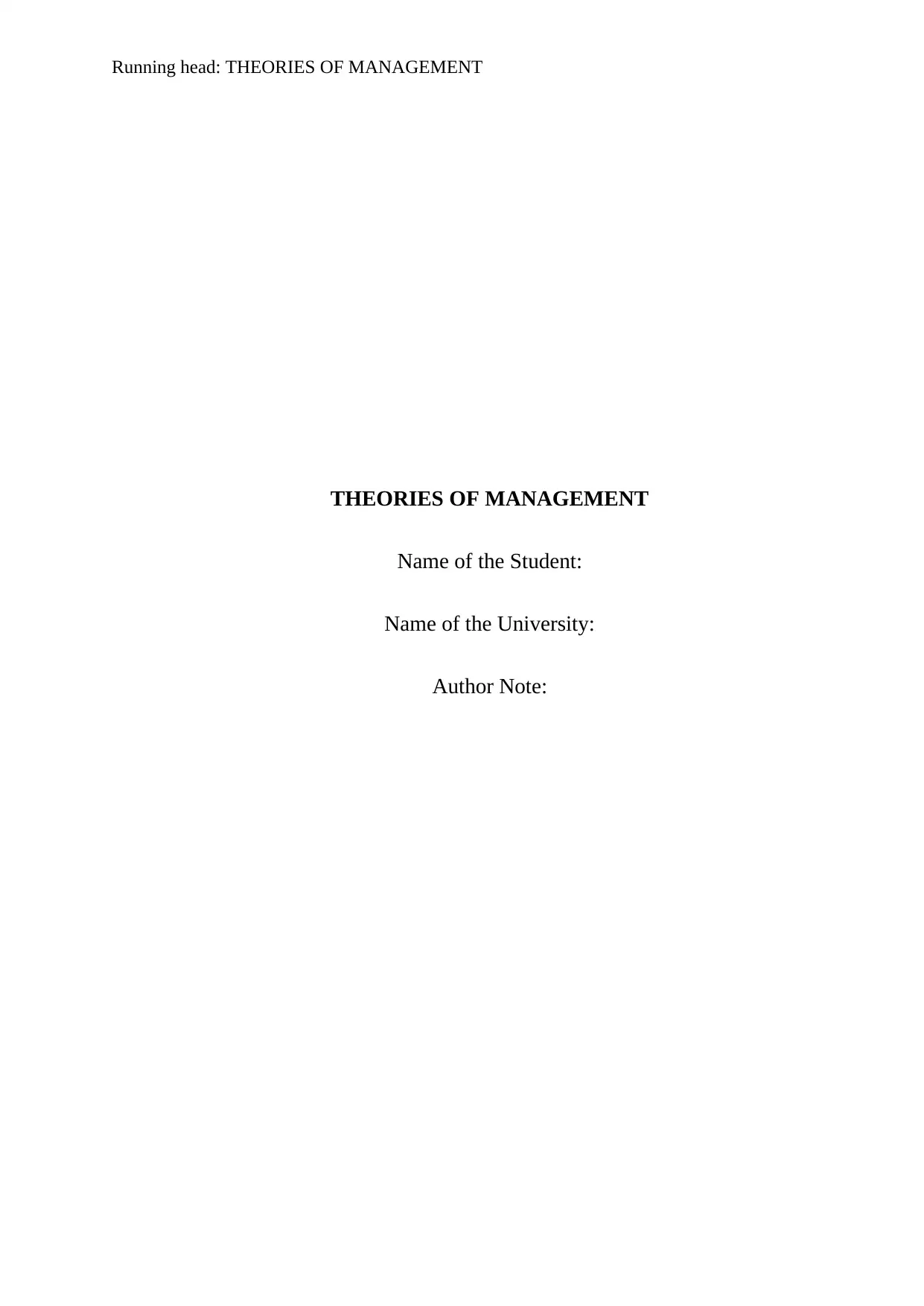
Running head: THEORIES OF MANAGEMENT
THEORIES OF MANAGEMENT
Name of the Student:
Name of the University:
Author Note:
THEORIES OF MANAGEMENT
Name of the Student:
Name of the University:
Author Note:
Secure Best Marks with AI Grader
Need help grading? Try our AI Grader for instant feedback on your assignments.
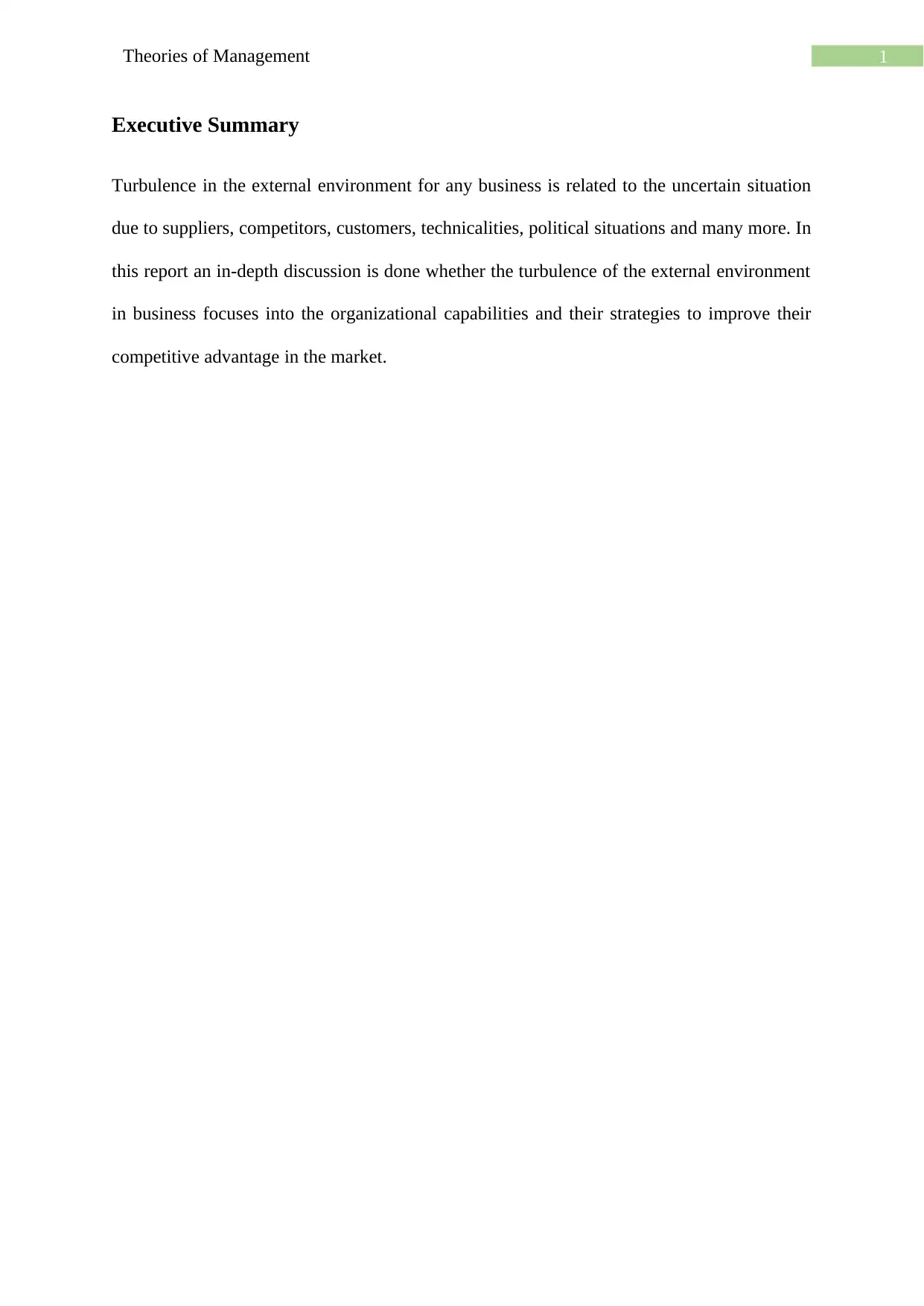
1Theories of Management
Executive Summary
Turbulence in the external environment for any business is related to the uncertain situation
due to suppliers, competitors, customers, technicalities, political situations and many more. In
this report an in-depth discussion is done whether the turbulence of the external environment
in business focuses into the organizational capabilities and their strategies to improve their
competitive advantage in the market.
Executive Summary
Turbulence in the external environment for any business is related to the uncertain situation
due to suppliers, competitors, customers, technicalities, political situations and many more. In
this report an in-depth discussion is done whether the turbulence of the external environment
in business focuses into the organizational capabilities and their strategies to improve their
competitive advantage in the market.
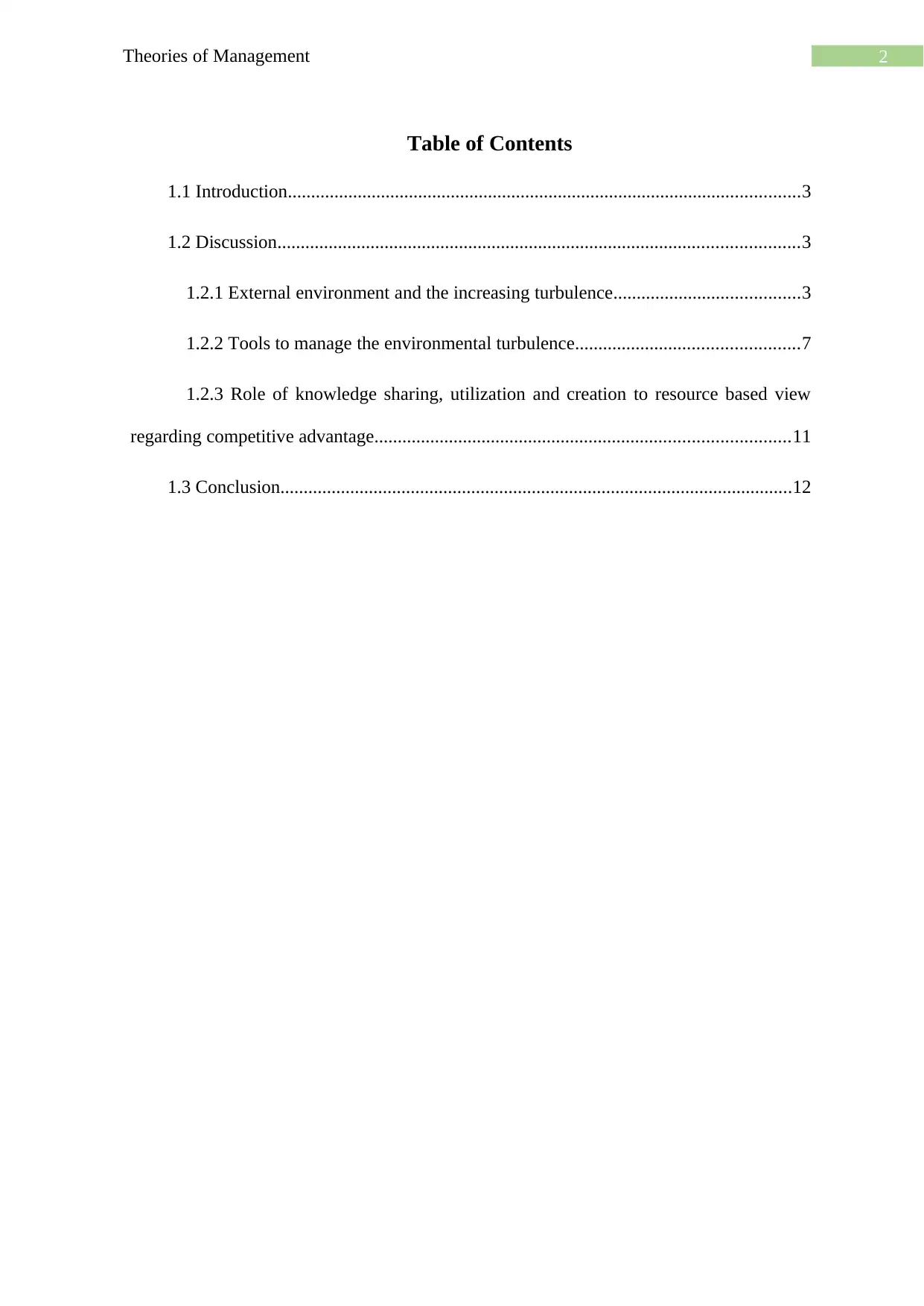
2Theories of Management
Table of Contents
1.1 Introduction..............................................................................................................3
1.2 Discussion................................................................................................................3
1.2.1 External environment and the increasing turbulence........................................3
1.2.2 Tools to manage the environmental turbulence................................................7
1.2.3 Role of knowledge sharing, utilization and creation to resource based view
regarding competitive advantage.........................................................................................11
1.3 Conclusion..............................................................................................................12
Table of Contents
1.1 Introduction..............................................................................................................3
1.2 Discussion................................................................................................................3
1.2.1 External environment and the increasing turbulence........................................3
1.2.2 Tools to manage the environmental turbulence................................................7
1.2.3 Role of knowledge sharing, utilization and creation to resource based view
regarding competitive advantage.........................................................................................11
1.3 Conclusion..............................................................................................................12
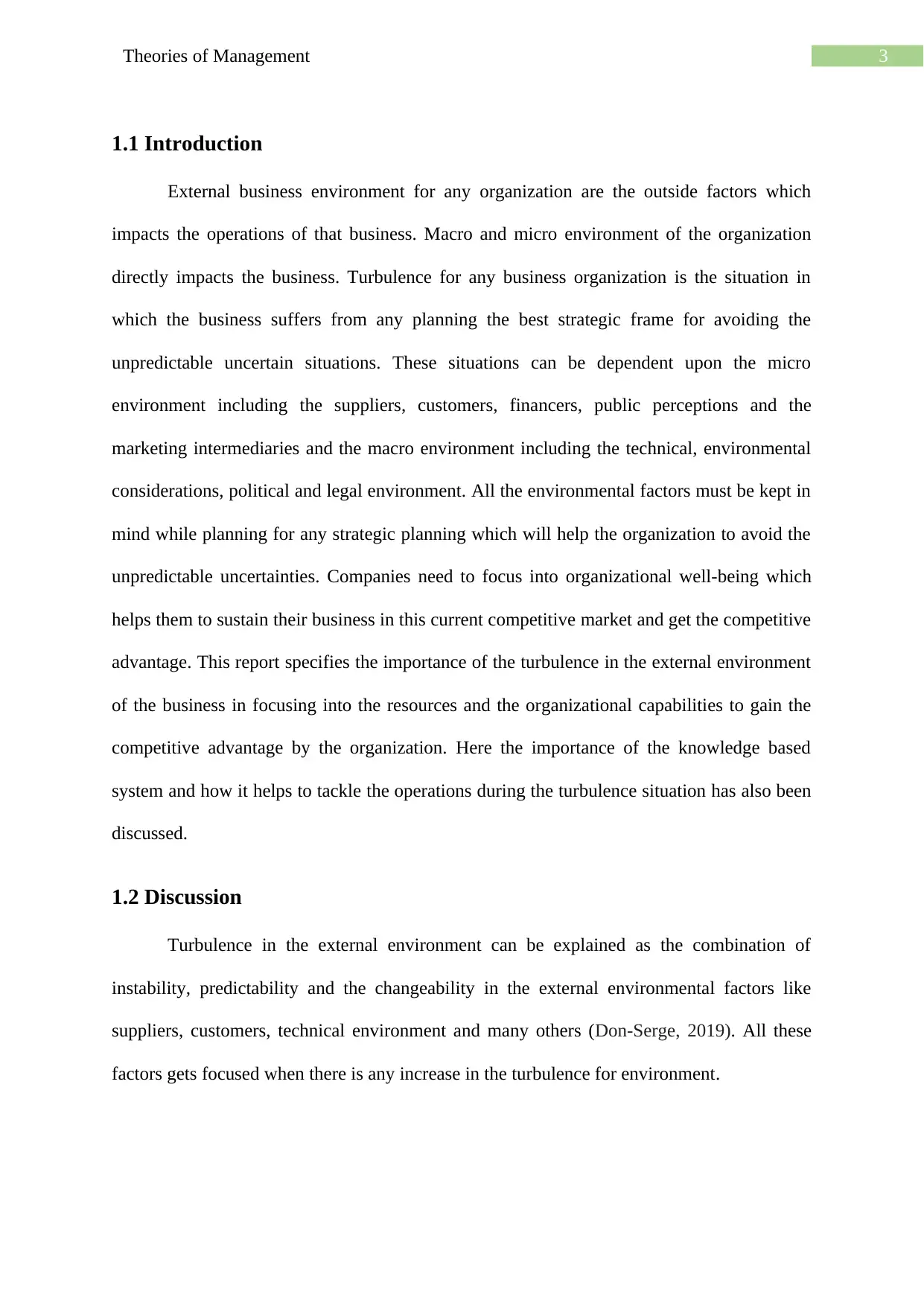
3Theories of Management
1.1 Introduction
External business environment for any organization are the outside factors which
impacts the operations of that business. Macro and micro environment of the organization
directly impacts the business. Turbulence for any business organization is the situation in
which the business suffers from any planning the best strategic frame for avoiding the
unpredictable uncertain situations. These situations can be dependent upon the micro
environment including the suppliers, customers, financers, public perceptions and the
marketing intermediaries and the macro environment including the technical, environmental
considerations, political and legal environment. All the environmental factors must be kept in
mind while planning for any strategic planning which will help the organization to avoid the
unpredictable uncertainties. Companies need to focus into organizational well-being which
helps them to sustain their business in this current competitive market and get the competitive
advantage. This report specifies the importance of the turbulence in the external environment
of the business in focusing into the resources and the organizational capabilities to gain the
competitive advantage by the organization. Here the importance of the knowledge based
system and how it helps to tackle the operations during the turbulence situation has also been
discussed.
1.2 Discussion
Turbulence in the external environment can be explained as the combination of
instability, predictability and the changeability in the external environmental factors like
suppliers, customers, technical environment and many others (Don-Serge, 2019). All these
factors gets focused when there is any increase in the turbulence for environment.
1.1 Introduction
External business environment for any organization are the outside factors which
impacts the operations of that business. Macro and micro environment of the organization
directly impacts the business. Turbulence for any business organization is the situation in
which the business suffers from any planning the best strategic frame for avoiding the
unpredictable uncertain situations. These situations can be dependent upon the micro
environment including the suppliers, customers, financers, public perceptions and the
marketing intermediaries and the macro environment including the technical, environmental
considerations, political and legal environment. All the environmental factors must be kept in
mind while planning for any strategic planning which will help the organization to avoid the
unpredictable uncertainties. Companies need to focus into organizational well-being which
helps them to sustain their business in this current competitive market and get the competitive
advantage. This report specifies the importance of the turbulence in the external environment
of the business in focusing into the resources and the organizational capabilities to gain the
competitive advantage by the organization. Here the importance of the knowledge based
system and how it helps to tackle the operations during the turbulence situation has also been
discussed.
1.2 Discussion
Turbulence in the external environment can be explained as the combination of
instability, predictability and the changeability in the external environmental factors like
suppliers, customers, technical environment and many others (Don-Serge, 2019). All these
factors gets focused when there is any increase in the turbulence for environment.
Secure Best Marks with AI Grader
Need help grading? Try our AI Grader for instant feedback on your assignments.
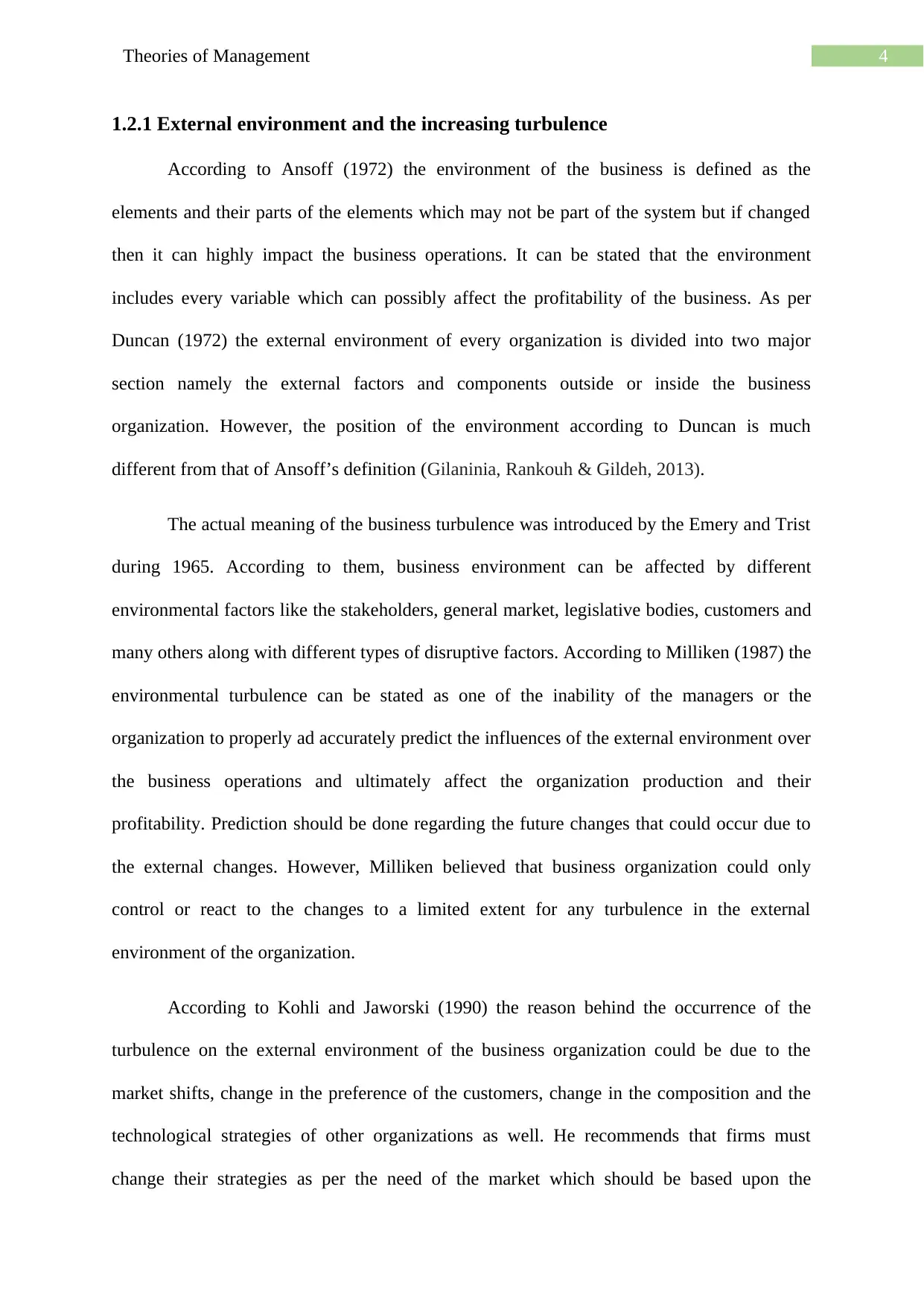
4Theories of Management
1.2.1 External environment and the increasing turbulence
According to Ansoff (1972) the environment of the business is defined as the
elements and their parts of the elements which may not be part of the system but if changed
then it can highly impact the business operations. It can be stated that the environment
includes every variable which can possibly affect the profitability of the business. As per
Duncan (1972) the external environment of every organization is divided into two major
section namely the external factors and components outside or inside the business
organization. However, the position of the environment according to Duncan is much
different from that of Ansoff’s definition (Gilaninia, Rankouh & Gildeh, 2013).
The actual meaning of the business turbulence was introduced by the Emery and Trist
during 1965. According to them, business environment can be affected by different
environmental factors like the stakeholders, general market, legislative bodies, customers and
many others along with different types of disruptive factors. According to Milliken (1987) the
environmental turbulence can be stated as one of the inability of the managers or the
organization to properly ad accurately predict the influences of the external environment over
the business operations and ultimately affect the organization production and their
profitability. Prediction should be done regarding the future changes that could occur due to
the external changes. However, Milliken believed that business organization could only
control or react to the changes to a limited extent for any turbulence in the external
environment of the organization.
According to Kohli and Jaworski (1990) the reason behind the occurrence of the
turbulence on the external environment of the business organization could be due to the
market shifts, change in the preference of the customers, change in the composition and the
technological strategies of other organizations as well. He recommends that firms must
change their strategies as per the need of the market which should be based upon the
1.2.1 External environment and the increasing turbulence
According to Ansoff (1972) the environment of the business is defined as the
elements and their parts of the elements which may not be part of the system but if changed
then it can highly impact the business operations. It can be stated that the environment
includes every variable which can possibly affect the profitability of the business. As per
Duncan (1972) the external environment of every organization is divided into two major
section namely the external factors and components outside or inside the business
organization. However, the position of the environment according to Duncan is much
different from that of Ansoff’s definition (Gilaninia, Rankouh & Gildeh, 2013).
The actual meaning of the business turbulence was introduced by the Emery and Trist
during 1965. According to them, business environment can be affected by different
environmental factors like the stakeholders, general market, legislative bodies, customers and
many others along with different types of disruptive factors. According to Milliken (1987) the
environmental turbulence can be stated as one of the inability of the managers or the
organization to properly ad accurately predict the influences of the external environment over
the business operations and ultimately affect the organization production and their
profitability. Prediction should be done regarding the future changes that could occur due to
the external changes. However, Milliken believed that business organization could only
control or react to the changes to a limited extent for any turbulence in the external
environment of the organization.
According to Kohli and Jaworski (1990) the reason behind the occurrence of the
turbulence on the external environment of the business organization could be due to the
market shifts, change in the preference of the customers, change in the composition and the
technological strategies of other organizations as well. He recommends that firms must
change their strategies as per the need of the market which should be based upon the
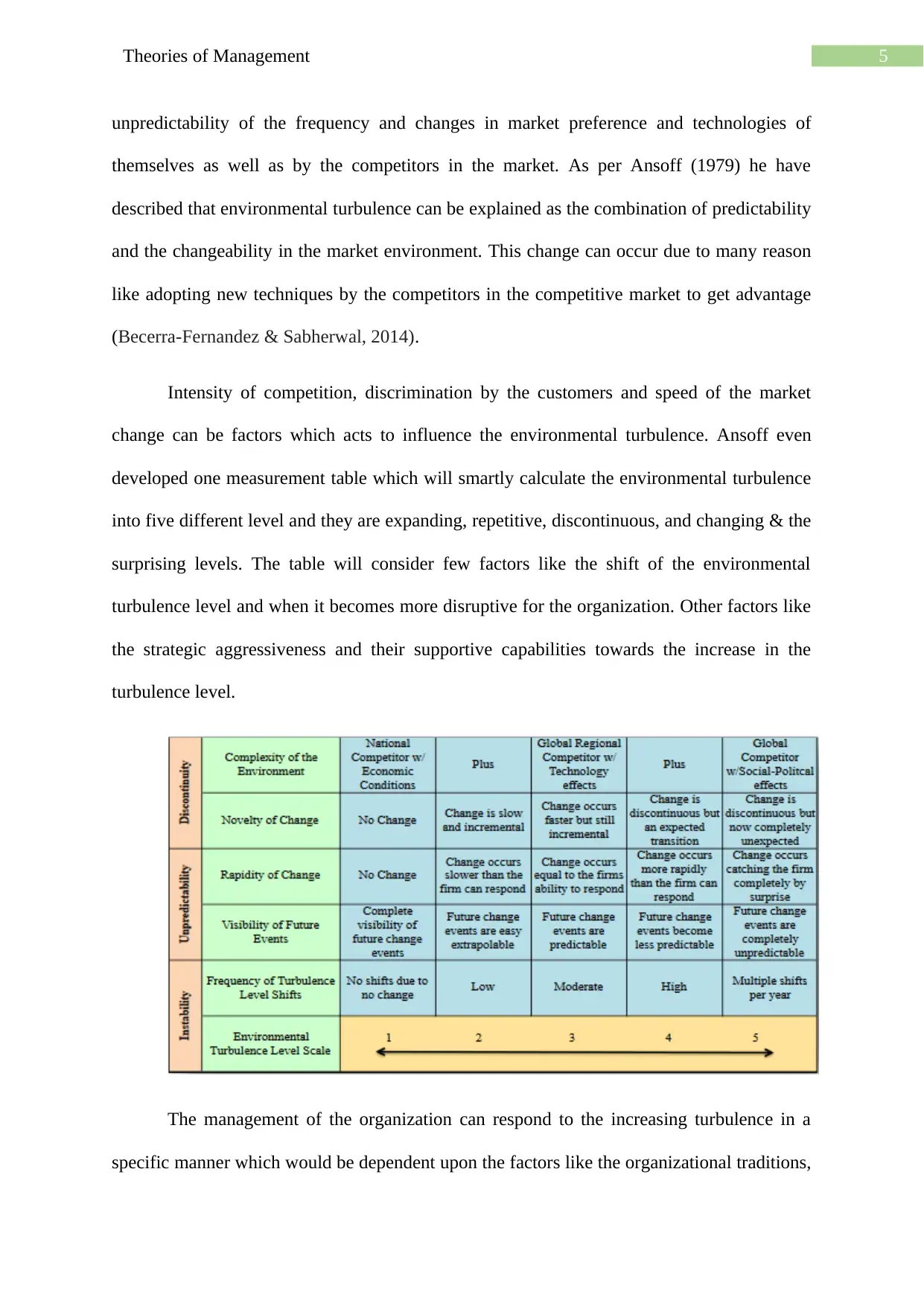
5Theories of Management
unpredictability of the frequency and changes in market preference and technologies of
themselves as well as by the competitors in the market. As per Ansoff (1979) he have
described that environmental turbulence can be explained as the combination of predictability
and the changeability in the market environment. This change can occur due to many reason
like adopting new techniques by the competitors in the competitive market to get advantage
(Becerra-Fernandez & Sabherwal, 2014).
Intensity of competition, discrimination by the customers and speed of the market
change can be factors which acts to influence the environmental turbulence. Ansoff even
developed one measurement table which will smartly calculate the environmental turbulence
into five different level and they are expanding, repetitive, discontinuous, and changing & the
surprising levels. The table will consider few factors like the shift of the environmental
turbulence level and when it becomes more disruptive for the organization. Other factors like
the strategic aggressiveness and their supportive capabilities towards the increase in the
turbulence level.
The management of the organization can respond to the increasing turbulence in a
specific manner which would be dependent upon the factors like the organizational traditions,
unpredictability of the frequency and changes in market preference and technologies of
themselves as well as by the competitors in the market. As per Ansoff (1979) he have
described that environmental turbulence can be explained as the combination of predictability
and the changeability in the market environment. This change can occur due to many reason
like adopting new techniques by the competitors in the competitive market to get advantage
(Becerra-Fernandez & Sabherwal, 2014).
Intensity of competition, discrimination by the customers and speed of the market
change can be factors which acts to influence the environmental turbulence. Ansoff even
developed one measurement table which will smartly calculate the environmental turbulence
into five different level and they are expanding, repetitive, discontinuous, and changing & the
surprising levels. The table will consider few factors like the shift of the environmental
turbulence level and when it becomes more disruptive for the organization. Other factors like
the strategic aggressiveness and their supportive capabilities towards the increase in the
turbulence level.
The management of the organization can respond to the increasing turbulence in a
specific manner which would be dependent upon the factors like the organizational traditions,
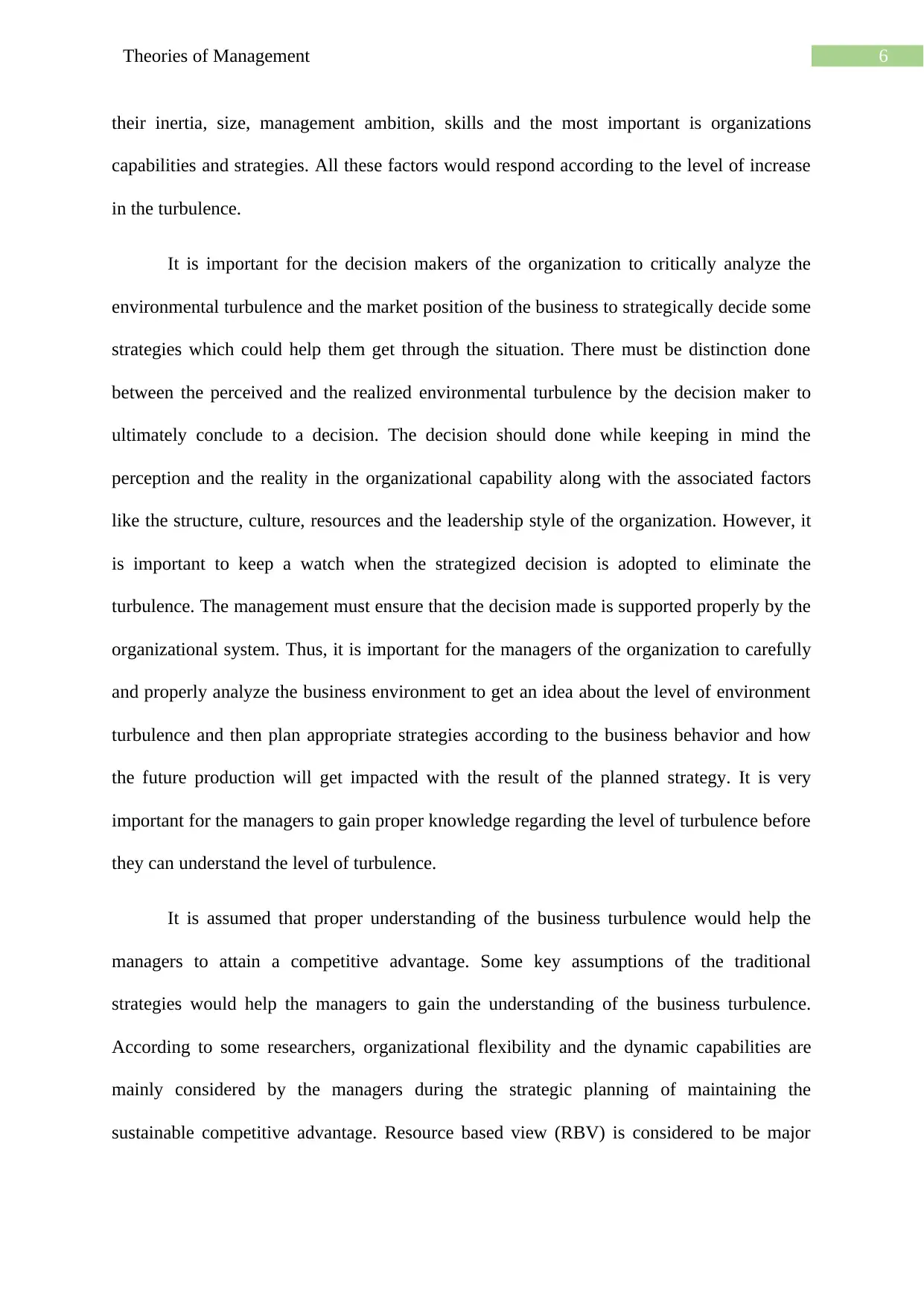
6Theories of Management
their inertia, size, management ambition, skills and the most important is organizations
capabilities and strategies. All these factors would respond according to the level of increase
in the turbulence.
It is important for the decision makers of the organization to critically analyze the
environmental turbulence and the market position of the business to strategically decide some
strategies which could help them get through the situation. There must be distinction done
between the perceived and the realized environmental turbulence by the decision maker to
ultimately conclude to a decision. The decision should done while keeping in mind the
perception and the reality in the organizational capability along with the associated factors
like the structure, culture, resources and the leadership style of the organization. However, it
is important to keep a watch when the strategized decision is adopted to eliminate the
turbulence. The management must ensure that the decision made is supported properly by the
organizational system. Thus, it is important for the managers of the organization to carefully
and properly analyze the business environment to get an idea about the level of environment
turbulence and then plan appropriate strategies according to the business behavior and how
the future production will get impacted with the result of the planned strategy. It is very
important for the managers to gain proper knowledge regarding the level of turbulence before
they can understand the level of turbulence.
It is assumed that proper understanding of the business turbulence would help the
managers to attain a competitive advantage. Some key assumptions of the traditional
strategies would help the managers to gain the understanding of the business turbulence.
According to some researchers, organizational flexibility and the dynamic capabilities are
mainly considered by the managers during the strategic planning of maintaining the
sustainable competitive advantage. Resource based view (RBV) is considered to be major
their inertia, size, management ambition, skills and the most important is organizations
capabilities and strategies. All these factors would respond according to the level of increase
in the turbulence.
It is important for the decision makers of the organization to critically analyze the
environmental turbulence and the market position of the business to strategically decide some
strategies which could help them get through the situation. There must be distinction done
between the perceived and the realized environmental turbulence by the decision maker to
ultimately conclude to a decision. The decision should done while keeping in mind the
perception and the reality in the organizational capability along with the associated factors
like the structure, culture, resources and the leadership style of the organization. However, it
is important to keep a watch when the strategized decision is adopted to eliminate the
turbulence. The management must ensure that the decision made is supported properly by the
organizational system. Thus, it is important for the managers of the organization to carefully
and properly analyze the business environment to get an idea about the level of environment
turbulence and then plan appropriate strategies according to the business behavior and how
the future production will get impacted with the result of the planned strategy. It is very
important for the managers to gain proper knowledge regarding the level of turbulence before
they can understand the level of turbulence.
It is assumed that proper understanding of the business turbulence would help the
managers to attain a competitive advantage. Some key assumptions of the traditional
strategies would help the managers to gain the understanding of the business turbulence.
According to some researchers, organizational flexibility and the dynamic capabilities are
mainly considered by the managers during the strategic planning of maintaining the
sustainable competitive advantage. Resource based view (RBV) is considered to be major
Paraphrase This Document
Need a fresh take? Get an instant paraphrase of this document with our AI Paraphraser
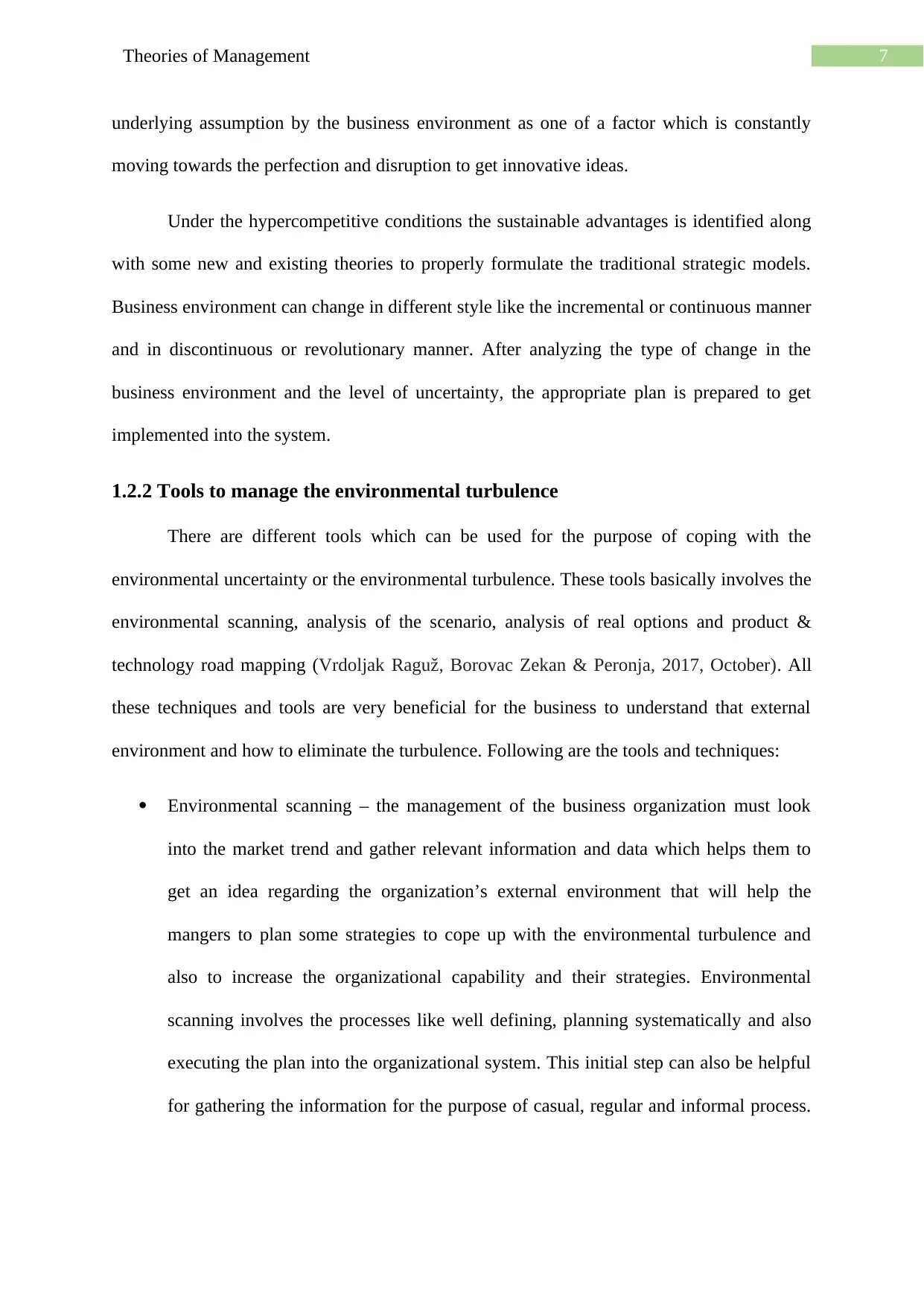
7Theories of Management
underlying assumption by the business environment as one of a factor which is constantly
moving towards the perfection and disruption to get innovative ideas.
Under the hypercompetitive conditions the sustainable advantages is identified along
with some new and existing theories to properly formulate the traditional strategic models.
Business environment can change in different style like the incremental or continuous manner
and in discontinuous or revolutionary manner. After analyzing the type of change in the
business environment and the level of uncertainty, the appropriate plan is prepared to get
implemented into the system.
1.2.2 Tools to manage the environmental turbulence
There are different tools which can be used for the purpose of coping with the
environmental uncertainty or the environmental turbulence. These tools basically involves the
environmental scanning, analysis of the scenario, analysis of real options and product &
technology road mapping (Vrdoljak Raguž, Borovac Zekan & Peronja, 2017, October). All
these techniques and tools are very beneficial for the business to understand that external
environment and how to eliminate the turbulence. Following are the tools and techniques:
Environmental scanning – the management of the business organization must look
into the market trend and gather relevant information and data which helps them to
get an idea regarding the organization’s external environment that will help the
mangers to plan some strategies to cope up with the environmental turbulence and
also to increase the organizational capability and their strategies. Environmental
scanning involves the processes like well defining, planning systematically and also
executing the plan into the organizational system. This initial step can also be helpful
for gathering the information for the purpose of casual, regular and informal process.
underlying assumption by the business environment as one of a factor which is constantly
moving towards the perfection and disruption to get innovative ideas.
Under the hypercompetitive conditions the sustainable advantages is identified along
with some new and existing theories to properly formulate the traditional strategic models.
Business environment can change in different style like the incremental or continuous manner
and in discontinuous or revolutionary manner. After analyzing the type of change in the
business environment and the level of uncertainty, the appropriate plan is prepared to get
implemented into the system.
1.2.2 Tools to manage the environmental turbulence
There are different tools which can be used for the purpose of coping with the
environmental uncertainty or the environmental turbulence. These tools basically involves the
environmental scanning, analysis of the scenario, analysis of real options and product &
technology road mapping (Vrdoljak Raguž, Borovac Zekan & Peronja, 2017, October). All
these techniques and tools are very beneficial for the business to understand that external
environment and how to eliminate the turbulence. Following are the tools and techniques:
Environmental scanning – the management of the business organization must look
into the market trend and gather relevant information and data which helps them to
get an idea regarding the organization’s external environment that will help the
mangers to plan some strategies to cope up with the environmental turbulence and
also to increase the organizational capability and their strategies. Environmental
scanning involves the processes like well defining, planning systematically and also
executing the plan into the organizational system. This initial step can also be helpful
for gathering the information for the purpose of casual, regular and informal process.
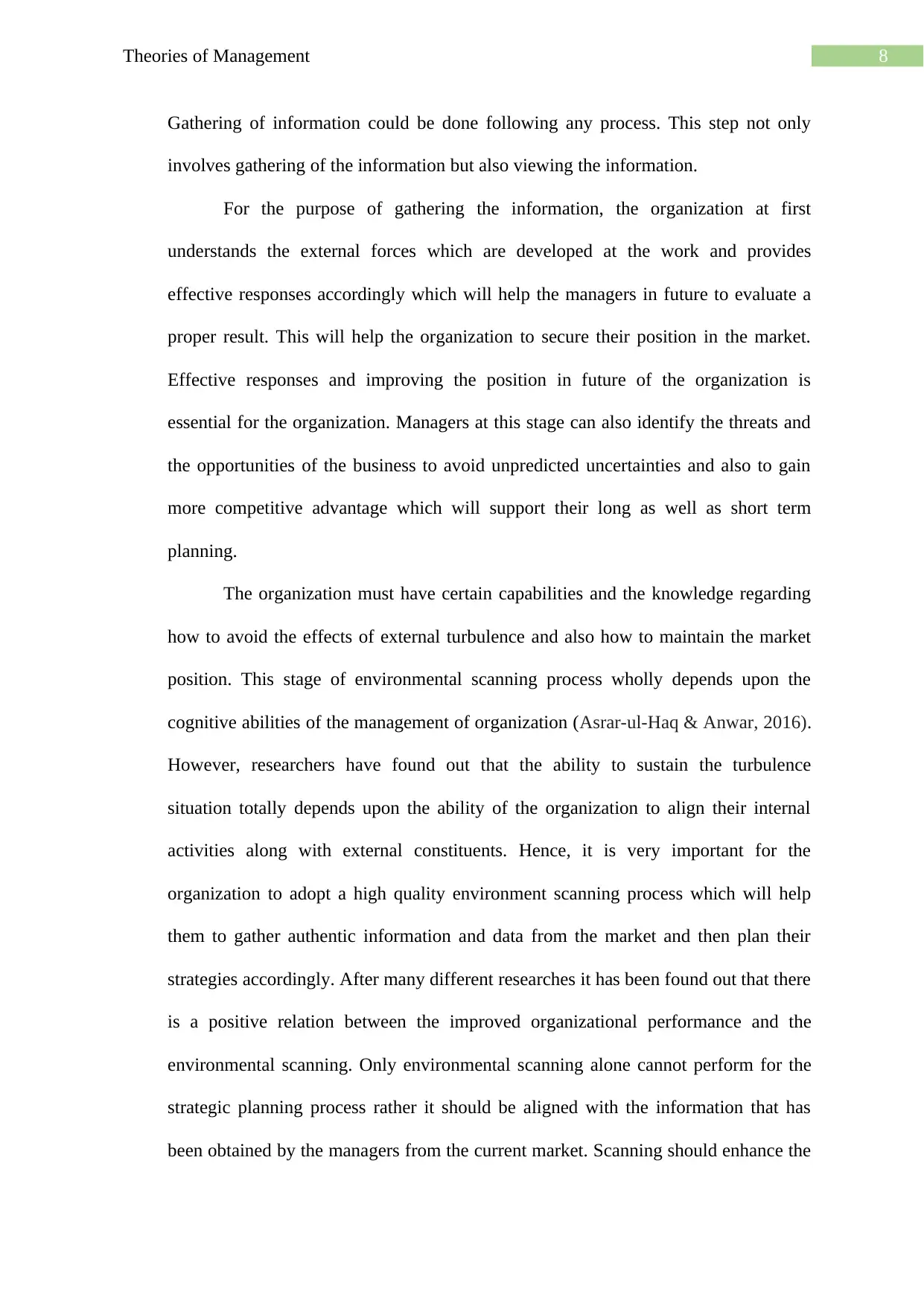
8Theories of Management
Gathering of information could be done following any process. This step not only
involves gathering of the information but also viewing the information.
For the purpose of gathering the information, the organization at first
understands the external forces which are developed at the work and provides
effective responses accordingly which will help the managers in future to evaluate a
proper result. This will help the organization to secure their position in the market.
Effective responses and improving the position in future of the organization is
essential for the organization. Managers at this stage can also identify the threats and
the opportunities of the business to avoid unpredicted uncertainties and also to gain
more competitive advantage which will support their long as well as short term
planning.
The organization must have certain capabilities and the knowledge regarding
how to avoid the effects of external turbulence and also how to maintain the market
position. This stage of environmental scanning process wholly depends upon the
cognitive abilities of the management of organization (Asrar-ul-Haq & Anwar, 2016).
However, researchers have found out that the ability to sustain the turbulence
situation totally depends upon the ability of the organization to align their internal
activities along with external constituents. Hence, it is very important for the
organization to adopt a high quality environment scanning process which will help
them to gather authentic information and data from the market and then plan their
strategies accordingly. After many different researches it has been found out that there
is a positive relation between the improved organizational performance and the
environmental scanning. Only environmental scanning alone cannot perform for the
strategic planning process rather it should be aligned with the information that has
been obtained by the managers from the current market. Scanning should enhance the
Gathering of information could be done following any process. This step not only
involves gathering of the information but also viewing the information.
For the purpose of gathering the information, the organization at first
understands the external forces which are developed at the work and provides
effective responses accordingly which will help the managers in future to evaluate a
proper result. This will help the organization to secure their position in the market.
Effective responses and improving the position in future of the organization is
essential for the organization. Managers at this stage can also identify the threats and
the opportunities of the business to avoid unpredicted uncertainties and also to gain
more competitive advantage which will support their long as well as short term
planning.
The organization must have certain capabilities and the knowledge regarding
how to avoid the effects of external turbulence and also how to maintain the market
position. This stage of environmental scanning process wholly depends upon the
cognitive abilities of the management of organization (Asrar-ul-Haq & Anwar, 2016).
However, researchers have found out that the ability to sustain the turbulence
situation totally depends upon the ability of the organization to align their internal
activities along with external constituents. Hence, it is very important for the
organization to adopt a high quality environment scanning process which will help
them to gather authentic information and data from the market and then plan their
strategies accordingly. After many different researches it has been found out that there
is a positive relation between the improved organizational performance and the
environmental scanning. Only environmental scanning alone cannot perform for the
strategic planning process rather it should be aligned with the information that has
been obtained by the managers from the current market. Scanning should enhance the
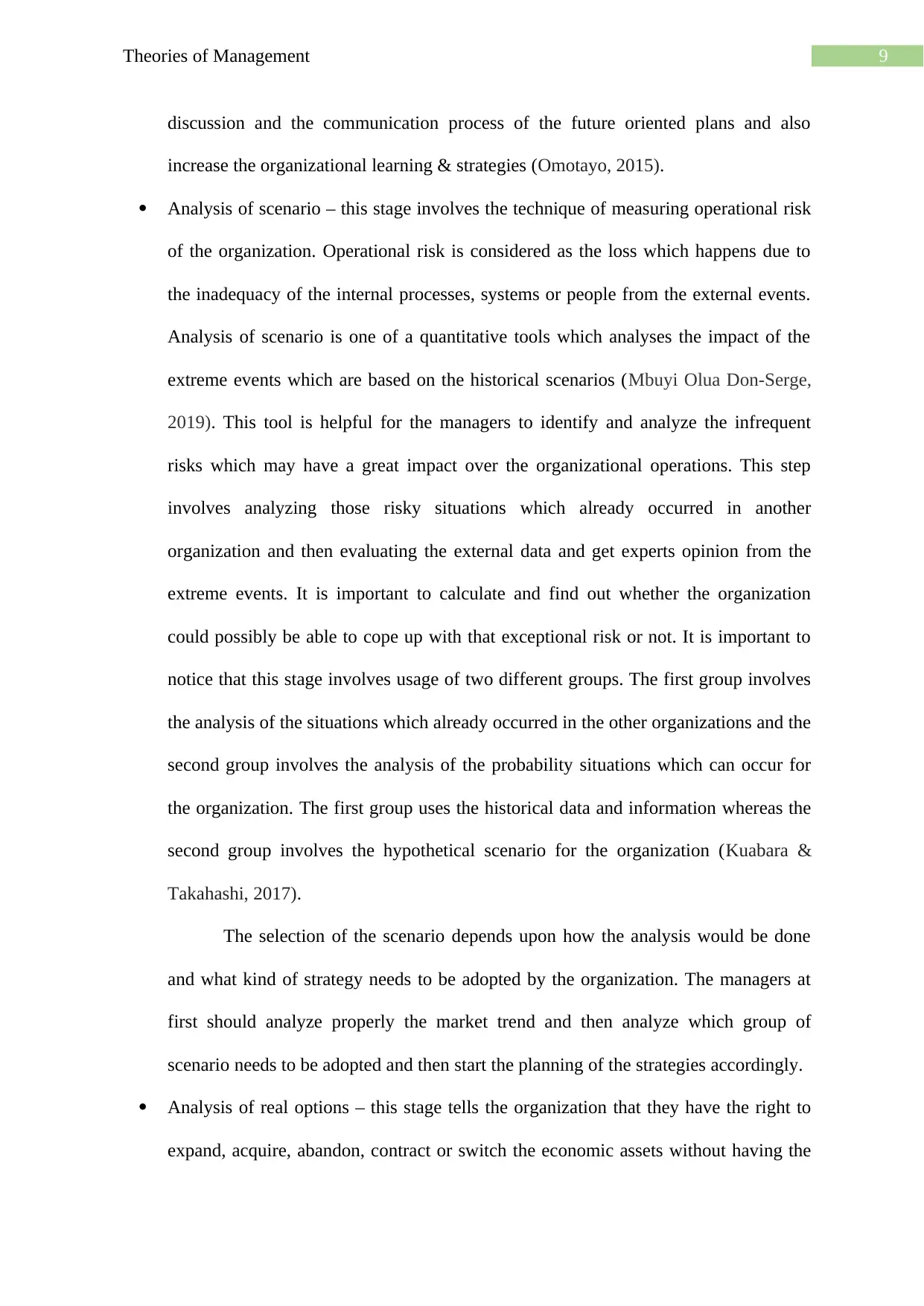
9Theories of Management
discussion and the communication process of the future oriented plans and also
increase the organizational learning & strategies (Omotayo, 2015).
Analysis of scenario – this stage involves the technique of measuring operational risk
of the organization. Operational risk is considered as the loss which happens due to
the inadequacy of the internal processes, systems or people from the external events.
Analysis of scenario is one of a quantitative tools which analyses the impact of the
extreme events which are based on the historical scenarios (Mbuyi Olua Don-Serge,
2019). This tool is helpful for the managers to identify and analyze the infrequent
risks which may have a great impact over the organizational operations. This step
involves analyzing those risky situations which already occurred in another
organization and then evaluating the external data and get experts opinion from the
extreme events. It is important to calculate and find out whether the organization
could possibly be able to cope up with that exceptional risk or not. It is important to
notice that this stage involves usage of two different groups. The first group involves
the analysis of the situations which already occurred in the other organizations and the
second group involves the analysis of the probability situations which can occur for
the organization. The first group uses the historical data and information whereas the
second group involves the hypothetical scenario for the organization (Kuabara &
Takahashi, 2017).
The selection of the scenario depends upon how the analysis would be done
and what kind of strategy needs to be adopted by the organization. The managers at
first should analyze properly the market trend and then analyze which group of
scenario needs to be adopted and then start the planning of the strategies accordingly.
Analysis of real options – this stage tells the organization that they have the right to
expand, acquire, abandon, contract or switch the economic assets without having the
discussion and the communication process of the future oriented plans and also
increase the organizational learning & strategies (Omotayo, 2015).
Analysis of scenario – this stage involves the technique of measuring operational risk
of the organization. Operational risk is considered as the loss which happens due to
the inadequacy of the internal processes, systems or people from the external events.
Analysis of scenario is one of a quantitative tools which analyses the impact of the
extreme events which are based on the historical scenarios (Mbuyi Olua Don-Serge,
2019). This tool is helpful for the managers to identify and analyze the infrequent
risks which may have a great impact over the organizational operations. This step
involves analyzing those risky situations which already occurred in another
organization and then evaluating the external data and get experts opinion from the
extreme events. It is important to calculate and find out whether the organization
could possibly be able to cope up with that exceptional risk or not. It is important to
notice that this stage involves usage of two different groups. The first group involves
the analysis of the situations which already occurred in the other organizations and the
second group involves the analysis of the probability situations which can occur for
the organization. The first group uses the historical data and information whereas the
second group involves the hypothetical scenario for the organization (Kuabara &
Takahashi, 2017).
The selection of the scenario depends upon how the analysis would be done
and what kind of strategy needs to be adopted by the organization. The managers at
first should analyze properly the market trend and then analyze which group of
scenario needs to be adopted and then start the planning of the strategies accordingly.
Analysis of real options – this stage tells the organization that they have the right to
expand, acquire, abandon, contract or switch the economic assets without having the
Secure Best Marks with AI Grader
Need help grading? Try our AI Grader for instant feedback on your assignments.
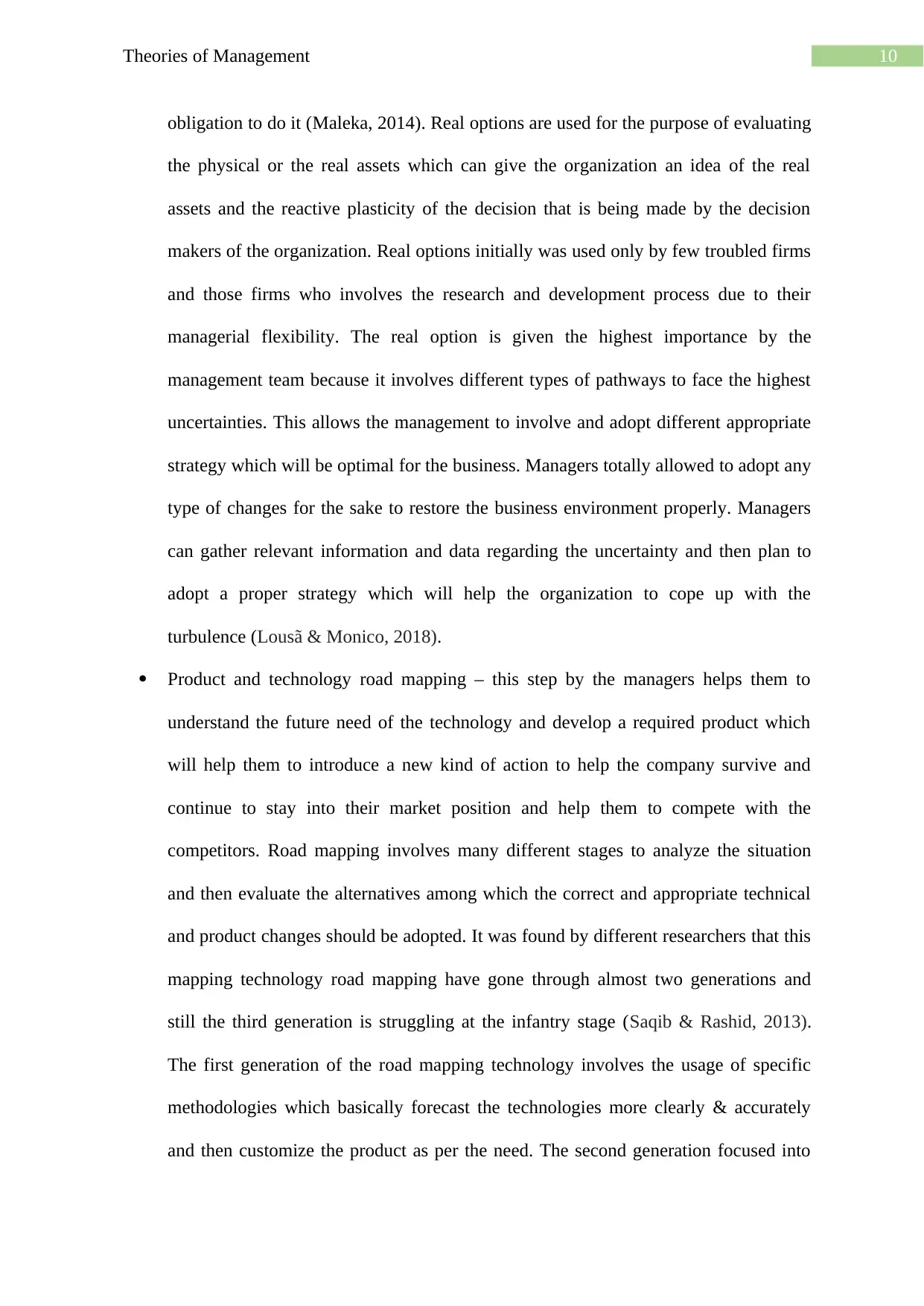
10Theories of Management
obligation to do it (Maleka, 2014). Real options are used for the purpose of evaluating
the physical or the real assets which can give the organization an idea of the real
assets and the reactive plasticity of the decision that is being made by the decision
makers of the organization. Real options initially was used only by few troubled firms
and those firms who involves the research and development process due to their
managerial flexibility. The real option is given the highest importance by the
management team because it involves different types of pathways to face the highest
uncertainties. This allows the management to involve and adopt different appropriate
strategy which will be optimal for the business. Managers totally allowed to adopt any
type of changes for the sake to restore the business environment properly. Managers
can gather relevant information and data regarding the uncertainty and then plan to
adopt a proper strategy which will help the organization to cope up with the
turbulence (Lousã & Monico, 2018).
Product and technology road mapping – this step by the managers helps them to
understand the future need of the technology and develop a required product which
will help them to introduce a new kind of action to help the company survive and
continue to stay into their market position and help them to compete with the
competitors. Road mapping involves many different stages to analyze the situation
and then evaluate the alternatives among which the correct and appropriate technical
and product changes should be adopted. It was found by different researchers that this
mapping technology road mapping have gone through almost two generations and
still the third generation is struggling at the infantry stage (Saqib & Rashid, 2013).
The first generation of the road mapping technology involves the usage of specific
methodologies which basically forecast the technologies more clearly & accurately
and then customize the product as per the need. The second generation focused into
obligation to do it (Maleka, 2014). Real options are used for the purpose of evaluating
the physical or the real assets which can give the organization an idea of the real
assets and the reactive plasticity of the decision that is being made by the decision
makers of the organization. Real options initially was used only by few troubled firms
and those firms who involves the research and development process due to their
managerial flexibility. The real option is given the highest importance by the
management team because it involves different types of pathways to face the highest
uncertainties. This allows the management to involve and adopt different appropriate
strategy which will be optimal for the business. Managers totally allowed to adopt any
type of changes for the sake to restore the business environment properly. Managers
can gather relevant information and data regarding the uncertainty and then plan to
adopt a proper strategy which will help the organization to cope up with the
turbulence (Lousã & Monico, 2018).
Product and technology road mapping – this step by the managers helps them to
understand the future need of the technology and develop a required product which
will help them to introduce a new kind of action to help the company survive and
continue to stay into their market position and help them to compete with the
competitors. Road mapping involves many different stages to analyze the situation
and then evaluate the alternatives among which the correct and appropriate technical
and product changes should be adopted. It was found by different researchers that this
mapping technology road mapping have gone through almost two generations and
still the third generation is struggling at the infantry stage (Saqib & Rashid, 2013).
The first generation of the road mapping technology involves the usage of specific
methodologies which basically forecast the technologies more clearly & accurately
and then customize the product as per the need. The second generation focused into
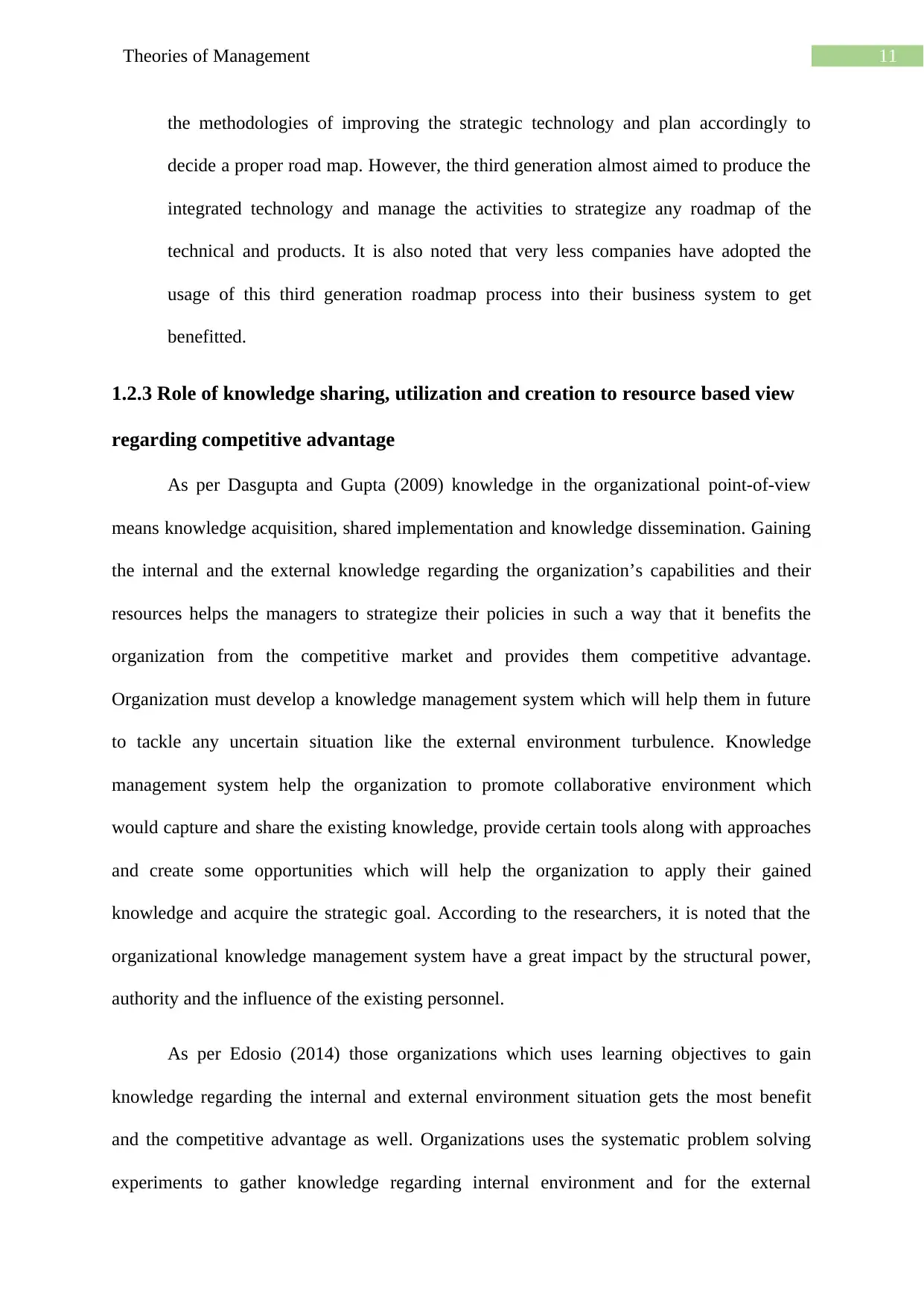
11Theories of Management
the methodologies of improving the strategic technology and plan accordingly to
decide a proper road map. However, the third generation almost aimed to produce the
integrated technology and manage the activities to strategize any roadmap of the
technical and products. It is also noted that very less companies have adopted the
usage of this third generation roadmap process into their business system to get
benefitted.
1.2.3 Role of knowledge sharing, utilization and creation to resource based view
regarding competitive advantage
As per Dasgupta and Gupta (2009) knowledge in the organizational point-of-view
means knowledge acquisition, shared implementation and knowledge dissemination. Gaining
the internal and the external knowledge regarding the organization’s capabilities and their
resources helps the managers to strategize their policies in such a way that it benefits the
organization from the competitive market and provides them competitive advantage.
Organization must develop a knowledge management system which will help them in future
to tackle any uncertain situation like the external environment turbulence. Knowledge
management system help the organization to promote collaborative environment which
would capture and share the existing knowledge, provide certain tools along with approaches
and create some opportunities which will help the organization to apply their gained
knowledge and acquire the strategic goal. According to the researchers, it is noted that the
organizational knowledge management system have a great impact by the structural power,
authority and the influence of the existing personnel.
As per Edosio (2014) those organizations which uses learning objectives to gain
knowledge regarding the internal and external environment situation gets the most benefit
and the competitive advantage as well. Organizations uses the systematic problem solving
experiments to gather knowledge regarding internal environment and for the external
the methodologies of improving the strategic technology and plan accordingly to
decide a proper road map. However, the third generation almost aimed to produce the
integrated technology and manage the activities to strategize any roadmap of the
technical and products. It is also noted that very less companies have adopted the
usage of this third generation roadmap process into their business system to get
benefitted.
1.2.3 Role of knowledge sharing, utilization and creation to resource based view
regarding competitive advantage
As per Dasgupta and Gupta (2009) knowledge in the organizational point-of-view
means knowledge acquisition, shared implementation and knowledge dissemination. Gaining
the internal and the external knowledge regarding the organization’s capabilities and their
resources helps the managers to strategize their policies in such a way that it benefits the
organization from the competitive market and provides them competitive advantage.
Organization must develop a knowledge management system which will help them in future
to tackle any uncertain situation like the external environment turbulence. Knowledge
management system help the organization to promote collaborative environment which
would capture and share the existing knowledge, provide certain tools along with approaches
and create some opportunities which will help the organization to apply their gained
knowledge and acquire the strategic goal. According to the researchers, it is noted that the
organizational knowledge management system have a great impact by the structural power,
authority and the influence of the existing personnel.
As per Edosio (2014) those organizations which uses learning objectives to gain
knowledge regarding the internal and external environment situation gets the most benefit
and the competitive advantage as well. Organizations uses the systematic problem solving
experiments to gather knowledge regarding internal environment and for the external
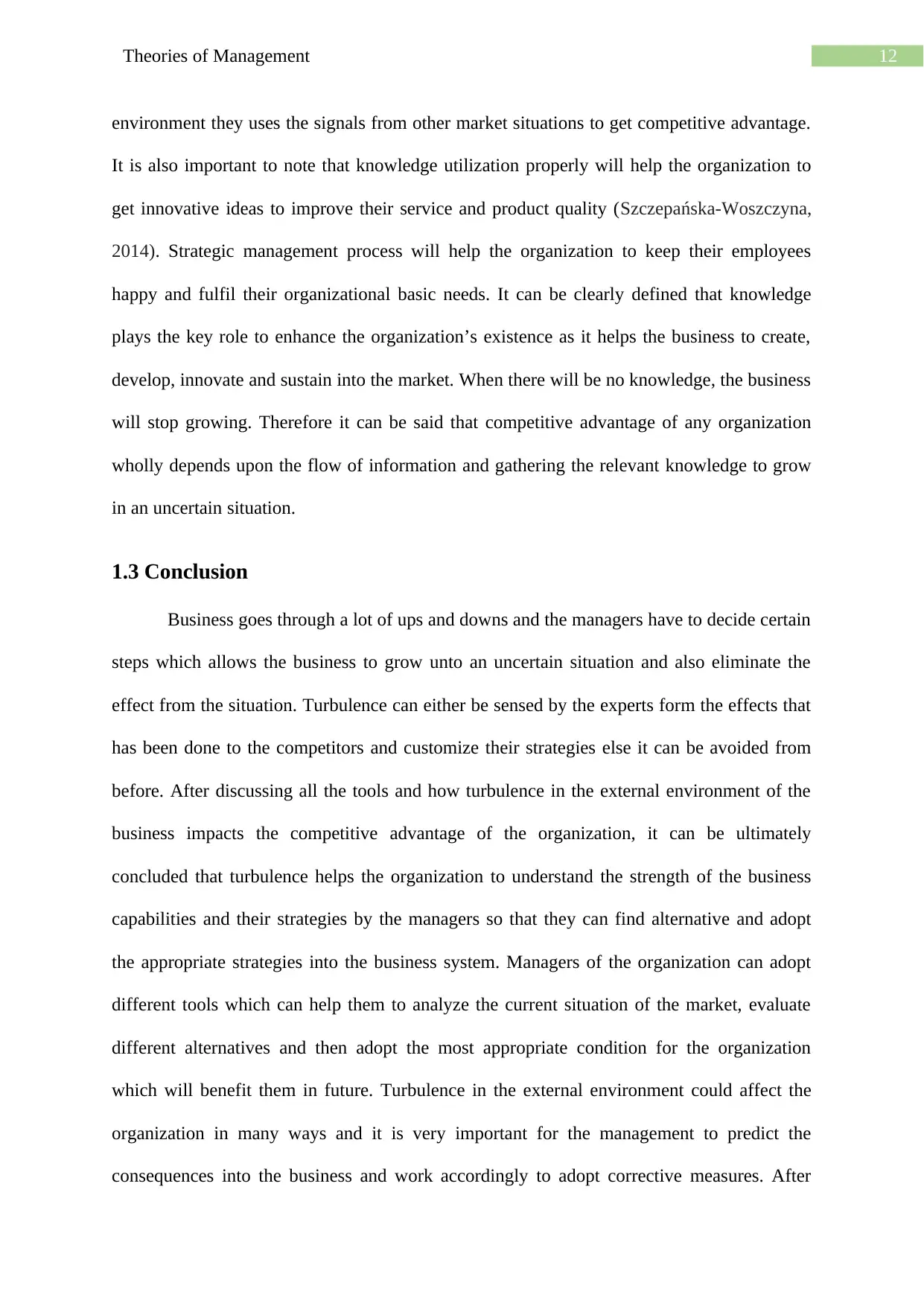
12Theories of Management
environment they uses the signals from other market situations to get competitive advantage.
It is also important to note that knowledge utilization properly will help the organization to
get innovative ideas to improve their service and product quality (Szczepańska-Woszczyna,
2014). Strategic management process will help the organization to keep their employees
happy and fulfil their organizational basic needs. It can be clearly defined that knowledge
plays the key role to enhance the organization’s existence as it helps the business to create,
develop, innovate and sustain into the market. When there will be no knowledge, the business
will stop growing. Therefore it can be said that competitive advantage of any organization
wholly depends upon the flow of information and gathering the relevant knowledge to grow
in an uncertain situation.
1.3 Conclusion
Business goes through a lot of ups and downs and the managers have to decide certain
steps which allows the business to grow unto an uncertain situation and also eliminate the
effect from the situation. Turbulence can either be sensed by the experts form the effects that
has been done to the competitors and customize their strategies else it can be avoided from
before. After discussing all the tools and how turbulence in the external environment of the
business impacts the competitive advantage of the organization, it can be ultimately
concluded that turbulence helps the organization to understand the strength of the business
capabilities and their strategies by the managers so that they can find alternative and adopt
the appropriate strategies into the business system. Managers of the organization can adopt
different tools which can help them to analyze the current situation of the market, evaluate
different alternatives and then adopt the most appropriate condition for the organization
which will benefit them in future. Turbulence in the external environment could affect the
organization in many ways and it is very important for the management to predict the
consequences into the business and work accordingly to adopt corrective measures. After
environment they uses the signals from other market situations to get competitive advantage.
It is also important to note that knowledge utilization properly will help the organization to
get innovative ideas to improve their service and product quality (Szczepańska-Woszczyna,
2014). Strategic management process will help the organization to keep their employees
happy and fulfil their organizational basic needs. It can be clearly defined that knowledge
plays the key role to enhance the organization’s existence as it helps the business to create,
develop, innovate and sustain into the market. When there will be no knowledge, the business
will stop growing. Therefore it can be said that competitive advantage of any organization
wholly depends upon the flow of information and gathering the relevant knowledge to grow
in an uncertain situation.
1.3 Conclusion
Business goes through a lot of ups and downs and the managers have to decide certain
steps which allows the business to grow unto an uncertain situation and also eliminate the
effect from the situation. Turbulence can either be sensed by the experts form the effects that
has been done to the competitors and customize their strategies else it can be avoided from
before. After discussing all the tools and how turbulence in the external environment of the
business impacts the competitive advantage of the organization, it can be ultimately
concluded that turbulence helps the organization to understand the strength of the business
capabilities and their strategies by the managers so that they can find alternative and adopt
the appropriate strategies into the business system. Managers of the organization can adopt
different tools which can help them to analyze the current situation of the market, evaluate
different alternatives and then adopt the most appropriate condition for the organization
which will benefit them in future. Turbulence in the external environment could affect the
organization in many ways and it is very important for the management to predict the
consequences into the business and work accordingly to adopt corrective measures. After
Paraphrase This Document
Need a fresh take? Get an instant paraphrase of this document with our AI Paraphraser
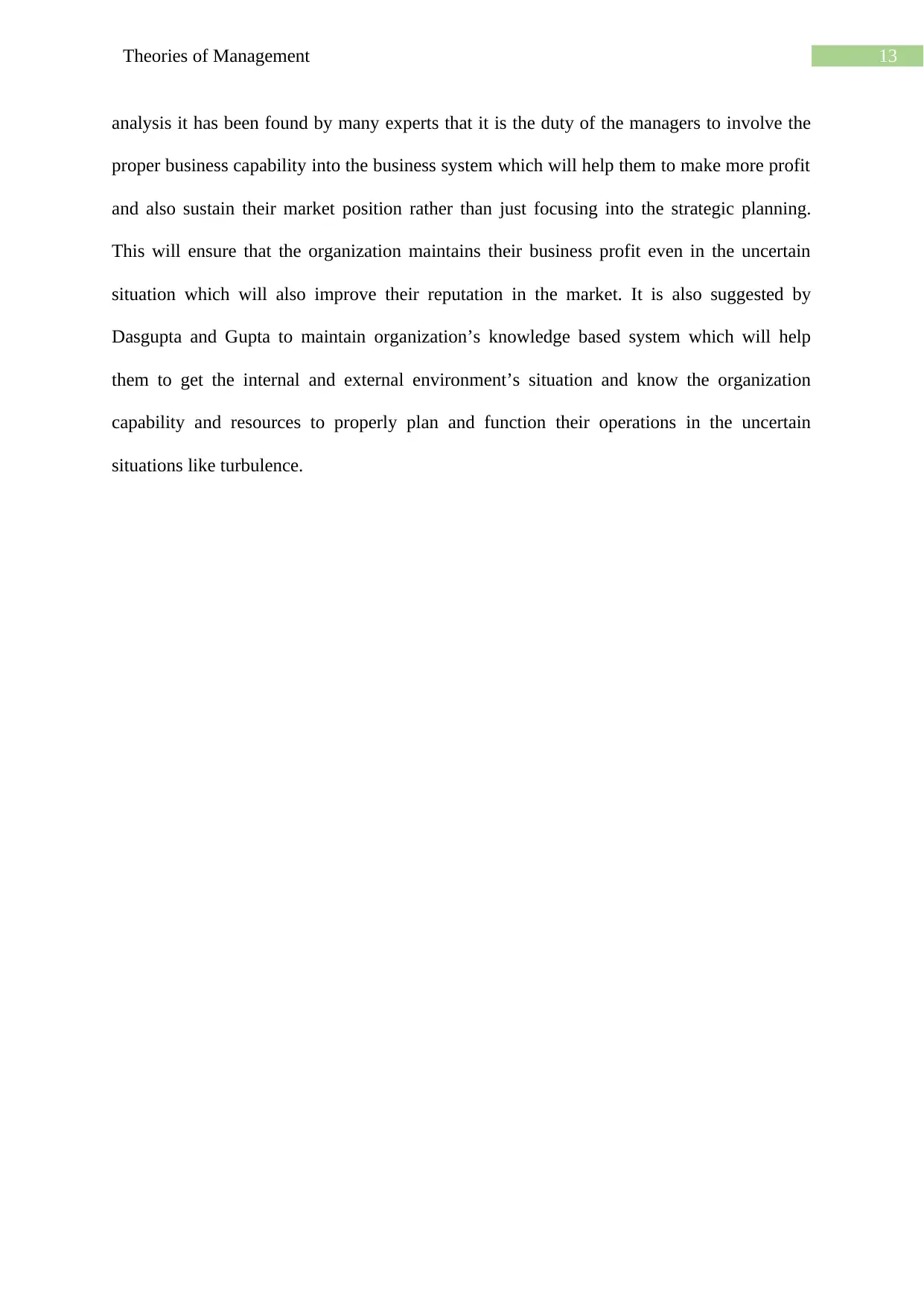
13Theories of Management
analysis it has been found by many experts that it is the duty of the managers to involve the
proper business capability into the business system which will help them to make more profit
and also sustain their market position rather than just focusing into the strategic planning.
This will ensure that the organization maintains their business profit even in the uncertain
situation which will also improve their reputation in the market. It is also suggested by
Dasgupta and Gupta to maintain organization’s knowledge based system which will help
them to get the internal and external environment’s situation and know the organization
capability and resources to properly plan and function their operations in the uncertain
situations like turbulence.
analysis it has been found by many experts that it is the duty of the managers to involve the
proper business capability into the business system which will help them to make more profit
and also sustain their market position rather than just focusing into the strategic planning.
This will ensure that the organization maintains their business profit even in the uncertain
situation which will also improve their reputation in the market. It is also suggested by
Dasgupta and Gupta to maintain organization’s knowledge based system which will help
them to get the internal and external environment’s situation and know the organization
capability and resources to properly plan and function their operations in the uncertain
situations like turbulence.
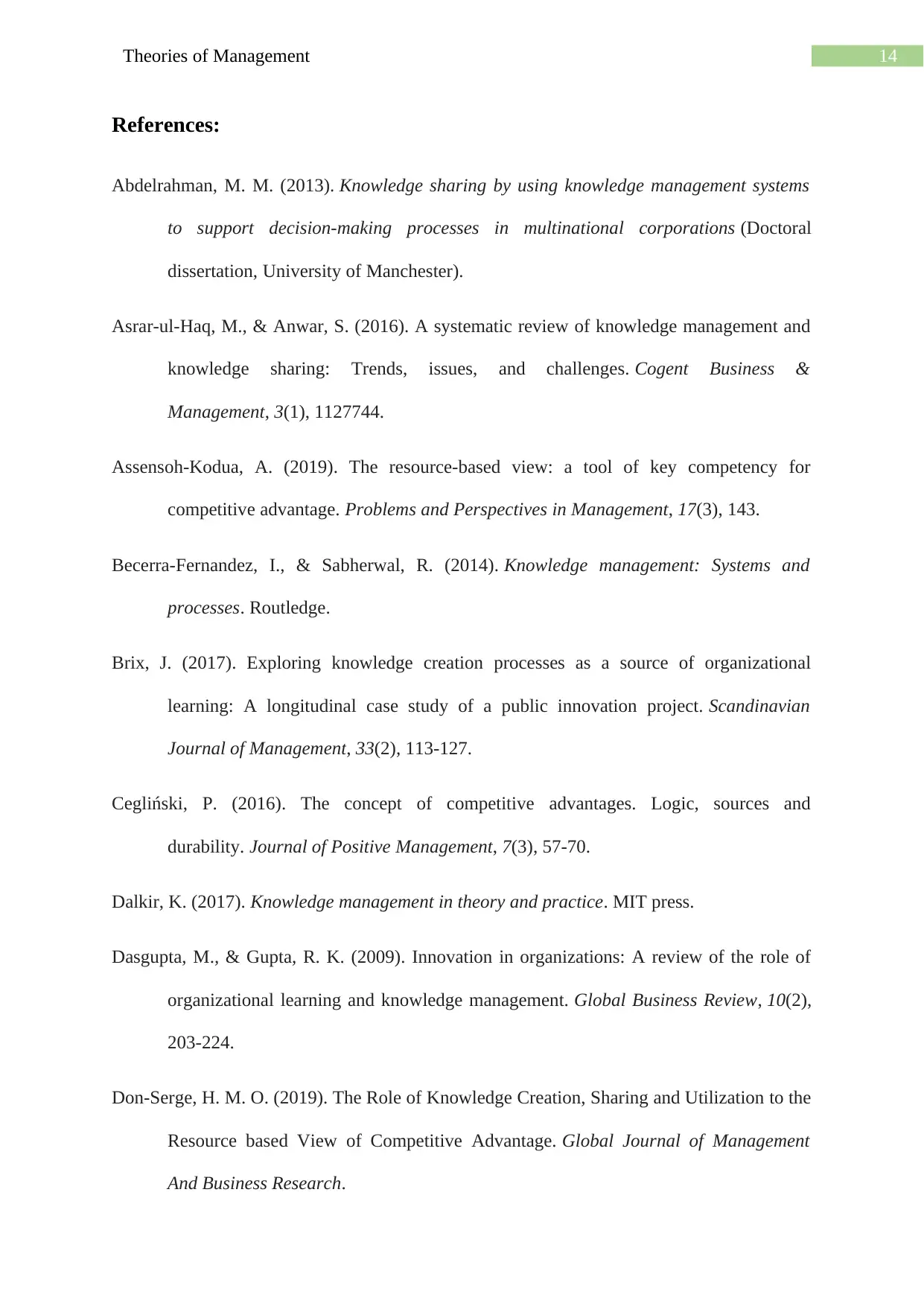
14Theories of Management
References:
Abdelrahman, M. M. (2013). Knowledge sharing by using knowledge management systems
to support decision-making processes in multinational corporations (Doctoral
dissertation, University of Manchester).
Asrar-ul-Haq, M., & Anwar, S. (2016). A systematic review of knowledge management and
knowledge sharing: Trends, issues, and challenges. Cogent Business &
Management, 3(1), 1127744.
Assensoh-Kodua, A. (2019). The resource-based view: a tool of key competency for
competitive advantage. Problems and Perspectives in Management, 17(3), 143.
Becerra-Fernandez, I., & Sabherwal, R. (2014). Knowledge management: Systems and
processes. Routledge.
Brix, J. (2017). Exploring knowledge creation processes as a source of organizational
learning: A longitudinal case study of a public innovation project. Scandinavian
Journal of Management, 33(2), 113-127.
Cegliński, P. (2016). The concept of competitive advantages. Logic, sources and
durability. Journal of Positive Management, 7(3), 57-70.
Dalkir, K. (2017). Knowledge management in theory and practice. MIT press.
Dasgupta, M., & Gupta, R. K. (2009). Innovation in organizations: A review of the role of
organizational learning and knowledge management. Global Business Review, 10(2),
203-224.
Don-Serge, H. M. O. (2019). The Role of Knowledge Creation, Sharing and Utilization to the
Resource based View of Competitive Advantage. Global Journal of Management
And Business Research.
References:
Abdelrahman, M. M. (2013). Knowledge sharing by using knowledge management systems
to support decision-making processes in multinational corporations (Doctoral
dissertation, University of Manchester).
Asrar-ul-Haq, M., & Anwar, S. (2016). A systematic review of knowledge management and
knowledge sharing: Trends, issues, and challenges. Cogent Business &
Management, 3(1), 1127744.
Assensoh-Kodua, A. (2019). The resource-based view: a tool of key competency for
competitive advantage. Problems and Perspectives in Management, 17(3), 143.
Becerra-Fernandez, I., & Sabherwal, R. (2014). Knowledge management: Systems and
processes. Routledge.
Brix, J. (2017). Exploring knowledge creation processes as a source of organizational
learning: A longitudinal case study of a public innovation project. Scandinavian
Journal of Management, 33(2), 113-127.
Cegliński, P. (2016). The concept of competitive advantages. Logic, sources and
durability. Journal of Positive Management, 7(3), 57-70.
Dalkir, K. (2017). Knowledge management in theory and practice. MIT press.
Dasgupta, M., & Gupta, R. K. (2009). Innovation in organizations: A review of the role of
organizational learning and knowledge management. Global Business Review, 10(2),
203-224.
Don-Serge, H. M. O. (2019). The Role of Knowledge Creation, Sharing and Utilization to the
Resource based View of Competitive Advantage. Global Journal of Management
And Business Research.
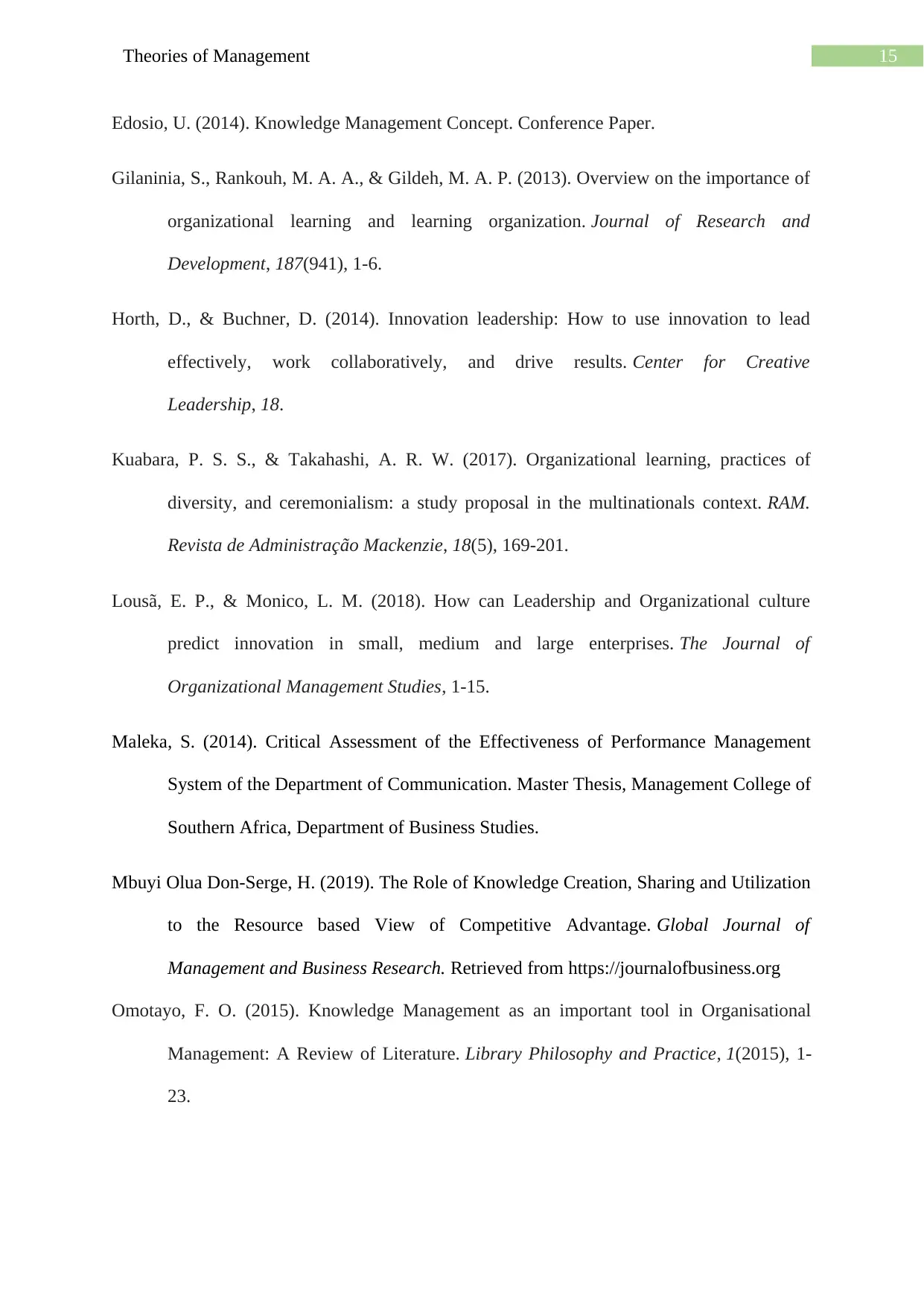
15Theories of Management
Edosio, U. (2014). Knowledge Management Concept. Conference Paper.
Gilaninia, S., Rankouh, M. A. A., & Gildeh, M. A. P. (2013). Overview on the importance of
organizational learning and learning organization. Journal of Research and
Development, 187(941), 1-6.
Horth, D., & Buchner, D. (2014). Innovation leadership: How to use innovation to lead
effectively, work collaboratively, and drive results. Center for Creative
Leadership, 18.
Kuabara, P. S. S., & Takahashi, A. R. W. (2017). Organizational learning, practices of
diversity, and ceremonialism: a study proposal in the multinationals context. RAM.
Revista de Administração Mackenzie, 18(5), 169-201.
Lousã, E. P., & Monico, L. M. (2018). How can Leadership and Organizational culture
predict innovation in small, medium and large enterprises. The Journal of
Organizational Management Studies, 1-15.
Maleka, S. (2014). Critical Assessment of the Effectiveness of Performance Management
System of the Department of Communication. Master Thesis, Management College of
Southern Africa, Department of Business Studies.
Mbuyi Olua Don-Serge, H. (2019). The Role of Knowledge Creation, Sharing and Utilization
to the Resource based View of Competitive Advantage. Global Journal of
Management and Business Research. Retrieved from https://journalofbusiness.org
Omotayo, F. O. (2015). Knowledge Management as an important tool in Organisational
Management: A Review of Literature. Library Philosophy and Practice, 1(2015), 1-
23.
Edosio, U. (2014). Knowledge Management Concept. Conference Paper.
Gilaninia, S., Rankouh, M. A. A., & Gildeh, M. A. P. (2013). Overview on the importance of
organizational learning and learning organization. Journal of Research and
Development, 187(941), 1-6.
Horth, D., & Buchner, D. (2014). Innovation leadership: How to use innovation to lead
effectively, work collaboratively, and drive results. Center for Creative
Leadership, 18.
Kuabara, P. S. S., & Takahashi, A. R. W. (2017). Organizational learning, practices of
diversity, and ceremonialism: a study proposal in the multinationals context. RAM.
Revista de Administração Mackenzie, 18(5), 169-201.
Lousã, E. P., & Monico, L. M. (2018). How can Leadership and Organizational culture
predict innovation in small, medium and large enterprises. The Journal of
Organizational Management Studies, 1-15.
Maleka, S. (2014). Critical Assessment of the Effectiveness of Performance Management
System of the Department of Communication. Master Thesis, Management College of
Southern Africa, Department of Business Studies.
Mbuyi Olua Don-Serge, H. (2019). The Role of Knowledge Creation, Sharing and Utilization
to the Resource based View of Competitive Advantage. Global Journal of
Management and Business Research. Retrieved from https://journalofbusiness.org
Omotayo, F. O. (2015). Knowledge Management as an important tool in Organisational
Management: A Review of Literature. Library Philosophy and Practice, 1(2015), 1-
23.
Secure Best Marks with AI Grader
Need help grading? Try our AI Grader for instant feedback on your assignments.
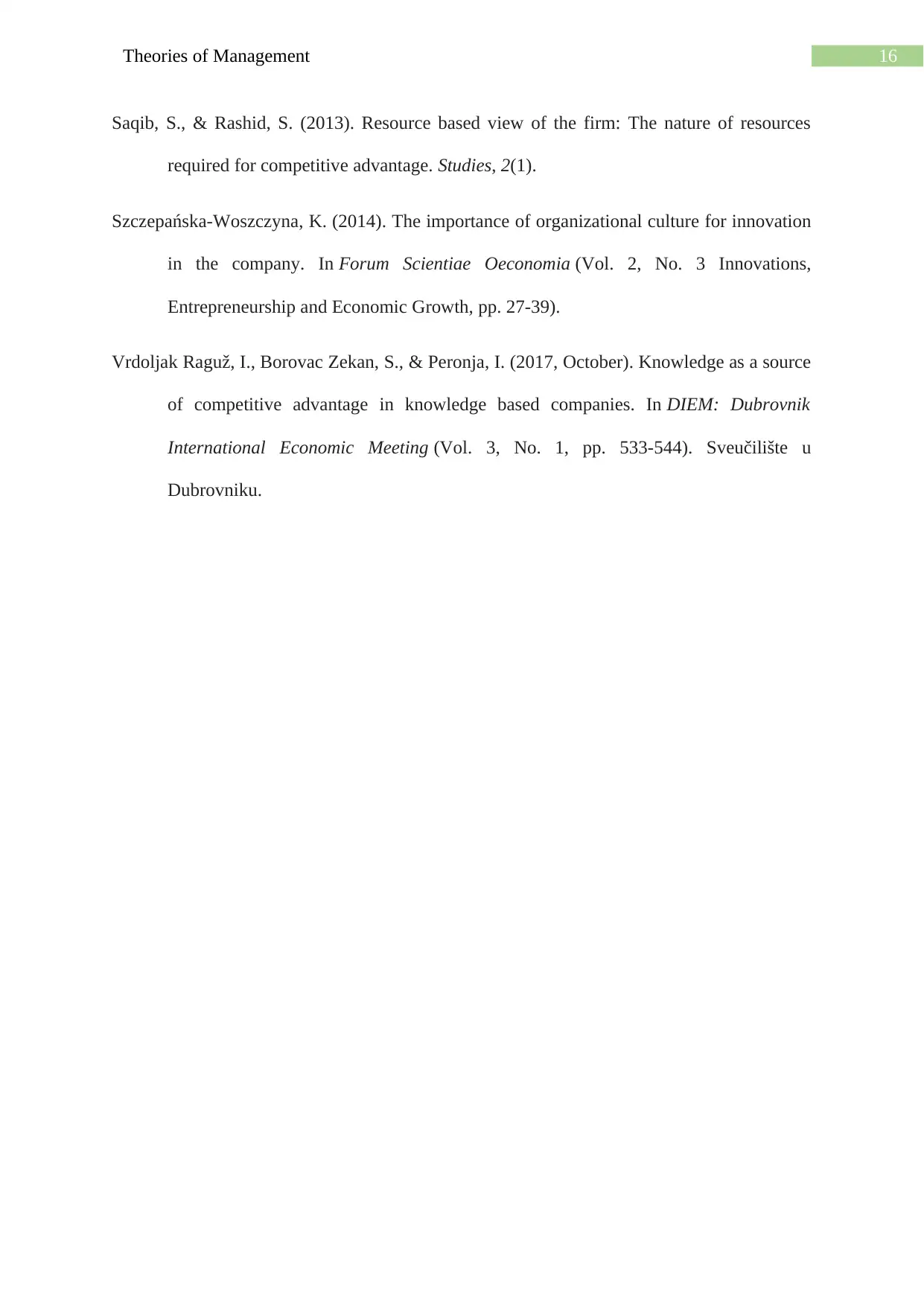
16Theories of Management
Saqib, S., & Rashid, S. (2013). Resource based view of the firm: The nature of resources
required for competitive advantage. Studies, 2(1).
Szczepańska-Woszczyna, K. (2014). The importance of organizational culture for innovation
in the company. In Forum Scientiae Oeconomia (Vol. 2, No. 3 Innovations,
Entrepreneurship and Economic Growth, pp. 27-39).
Vrdoljak Raguž, I., Borovac Zekan, S., & Peronja, I. (2017, October). Knowledge as a source
of competitive advantage in knowledge based companies. In DIEM: Dubrovnik
International Economic Meeting (Vol. 3, No. 1, pp. 533-544). Sveučilište u
Dubrovniku.
Saqib, S., & Rashid, S. (2013). Resource based view of the firm: The nature of resources
required for competitive advantage. Studies, 2(1).
Szczepańska-Woszczyna, K. (2014). The importance of organizational culture for innovation
in the company. In Forum Scientiae Oeconomia (Vol. 2, No. 3 Innovations,
Entrepreneurship and Economic Growth, pp. 27-39).
Vrdoljak Raguž, I., Borovac Zekan, S., & Peronja, I. (2017, October). Knowledge as a source
of competitive advantage in knowledge based companies. In DIEM: Dubrovnik
International Economic Meeting (Vol. 3, No. 1, pp. 533-544). Sveučilište u
Dubrovniku.
1 out of 17
Related Documents
Your All-in-One AI-Powered Toolkit for Academic Success.
+13062052269
info@desklib.com
Available 24*7 on WhatsApp / Email
![[object Object]](/_next/static/media/star-bottom.7253800d.svg)
Unlock your academic potential
© 2024 | Zucol Services PVT LTD | All rights reserved.





